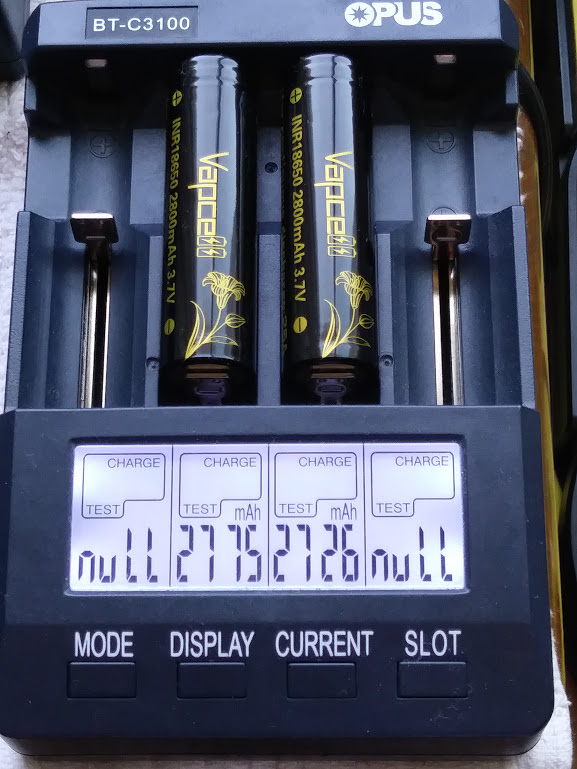These tests below only note the estimated ratings for these batteries at the time I tested them. Any battery that is not a genuine Samsung, Sony, LG, Panasonic, or Sanyo can change at any time! This is one of the hazards of using “rewrapped” or batteries from other manufacturers so carefully research any battery you are considering using before purchasing.
Misusing or mishandling lithium-ion batteries can pose a SERIOUS RISK of personal injury or property damage. They are not meant to be used outside of a protected battery pack. Never exceed the battery’s continuous current rating and keep the plastic wrap and top insulating ring in perfect condition.
Testing batteries at their limits is dangerous and should never, ever, be attempted by anyone who has not thoroughly studied the dangers involved, understands the risks, has the proper equipment, and takes all appropriate safety precautions.
If the battery has only one current rating number, or if it only says "max", then I have to assume the battery is rated at that current level for any type of discharge, including continuous.




Bottom Line
I tested two samples of this cell which has been popping up in Asia. I haven’t been able to get the datasheet but preliminary testing shows it’s probably rated at about 25A continuous and around 2700mAh-2800mAh. It hits harder and lasts longer than the VTC5A and its performance is about equal to that of the incredible VTC6A.
There is a Vapcell discharge graph showing this cell delivering a bit over 2900mAh but my two cells delivered 2742mAh and 2796mAh at 0.5A down to 2.5V. The Vapcell test used a 1A discharge for their test and that slight warming, versus the lower rate 0.5A rate used by me, can lower the internal resistance which allows the cell to run at a slightly higher voltage which means it can run for longer before hitting 2.5V.
[EDIT] A Dyson datasheet lists them at 2600mAh. I do not know if that is Sony’s rating or if Dyson is being conservative to increase cycle life.[/EDIT]
I do not know if this is why the Vapcell test shows this cell delivering over 2900mAh but the 1A discharge rate or a difference between the grade of the cells I had and what they had might explain it.
I do not know if the ones I tested are early production or pre-production samples so my ratings are just preliminary estimates for now. I will be retesting this cell when they become more available and will adjust the ratings if necessary then. I will also post their internal resistance and watt-hour specs then.
Two cells were donated for the purposes of testing by Vapcell (www.vapcelltech.com). Thank you!
Continuous Current Discharge Graphs

Ratings Graphic

Comparison to VTC5A and VTC6A

To see how other cells have tested check out this link: https://www.e-cigarette-forum.com/forum/blog-entry/list-of-battery-tests.7436/
Misusing or mishandling lithium-ion batteries can pose a SERIOUS RISK of personal injury or property damage. They are not meant to be used outside of a protected battery pack. Never exceed the battery’s continuous current rating and keep the plastic wrap and top insulating ring in perfect condition.
Testing batteries at their limits is dangerous and should never, ever, be attempted by anyone who has not thoroughly studied the dangers involved, understands the risks, has the proper equipment, and takes all appropriate safety precautions.
If the battery has only one current rating number, or if it only says "max", then I have to assume the battery is rated at that current level for any type of discharge, including continuous.


Bottom Line
I tested two samples of this cell which has been popping up in Asia. I haven’t been able to get the datasheet but preliminary testing shows it’s probably rated at about 25A continuous and around 2700mAh-2800mAh. It hits harder and lasts longer than the VTC5A and its performance is about equal to that of the incredible VTC6A.
There is a Vapcell discharge graph showing this cell delivering a bit over 2900mAh but my two cells delivered 2742mAh and 2796mAh at 0.5A down to 2.5V. The Vapcell test used a 1A discharge for their test and that slight warming, versus the lower rate 0.5A rate used by me, can lower the internal resistance which allows the cell to run at a slightly higher voltage which means it can run for longer before hitting 2.5V.
[EDIT] A Dyson datasheet lists them at 2600mAh. I do not know if that is Sony’s rating or if Dyson is being conservative to increase cycle life.[/EDIT]
I do not know if this is why the Vapcell test shows this cell delivering over 2900mAh but the 1A discharge rate or a difference between the grade of the cells I had and what they had might explain it.
I do not know if the ones I tested are early production or pre-production samples so my ratings are just preliminary estimates for now. I will be retesting this cell when they become more available and will adjust the ratings if necessary then. I will also post their internal resistance and watt-hour specs then.
Two cells were donated for the purposes of testing by Vapcell (www.vapcelltech.com). Thank you!
Continuous Current Discharge Graphs
Ratings Graphic

Comparison to VTC5A and VTC6A
To see how other cells have tested check out this link: https://www.e-cigarette-forum.com/forum/blog-entry/list-of-battery-tests.7436/
Last edited:


 ).
).



